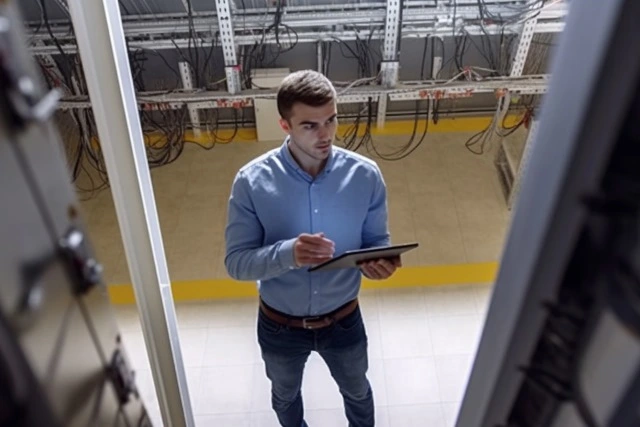On average, 30% of the energy used in commercial buildings goes to waste. Auditing energy usage allows your facility to identify these waste areas and reduce operating costs.
A commercial energy audit offers a standardized methodology to examine every building’s energy usage. This methodology allows you to compare your building’s energy usage patterns to other facilities to uncover energy-saving opportunities. You can track progress toward reducing energy-related costs and improving building efficiency. How do you conduct a commercial energy audit, and can it help your building?
What is the process and standard of a commercial energy audit?
Commercial energy audits generally start with collecting data on how your building uses energy and its equipment. Your audit should include data on your lighting systems, heating, ventilation, insulation, and more so it can pinpoint the sources of energy waste and identify opportunities for improvement. Oftentimes, your building management system already contains the data points you need.
Commercial energy audits adhere to industry standards and protocols to ensure accuracy and reliability. On-site assessments and measurements validate the collected data. It also allows auditors to understand better how your building consumes energy. This comprehensive analysis forms the foundation for a detailed report presenting actionable recommendations tailored to your building’s needs and goals.
Are there any specific phases or methods being used?
ASHRAE (American Society of Heating, Refrigerating, and Air-Conditioning Engineers) has established three levels of commercial energy audits. These levels include:
- Level 1 Walk-Through Survey: The first level is an essential evaluation called a Walk-Through Analysis or Preliminary Audit. Auditors quickly assess your building by reviewing available data and doing a walk-through. They identify simple and low-cost ways to save energy.
- Level 2 Energy Survey and Analysis: Level 2 is a more thorough assessment known as an Energy Survey and Analysis or General Energy Audit. Auditors collect detailed data, measure energy usage on-site, and analyze your building’s systems. They find opportunities for energy savings, evaluate cost-effectiveness, and provide specific recommendations for efficiency upgrades.
- Level 3 Detailed Analysis of Capital-Intensive Modifications: The highest level is a comprehensive evaluation called a Detailed Analysis of Capital-Intensive Modifications or Investment-Grade Audit. It is used for complex buildings or significant energy improvements. Auditors perform detailed calculations, simulations, and financial analyses. They create a comprehensive plan with energy savings projections, cost estimates, and financial analysis to support investment decisions.
On top of these three levels of commercial energy audits, ASHRAE also defines processes for targeted audits for specific building systems.
How to perform an energy audit of a commercial building
Commercial energy audits follow specific guidelines to generate reliable insights and data on how your building uses energy. You can conduct the audit and achieve energy cost reduction in five steps.
Reduce energy costs step-by-step
Here are five key stages to performing a commercial energy audit and effectively minimizing energy expenses:
- Set goals and gather information: Before starting the audit, set specific purposes, such as achieving an ESG Green Buildings certification. After setting goals, start the energy audit by collecting energy usage data. This can include utility bills, equipment details, and reports on how the building is used.
- Perform an on-site inspection and collect data: Auditors visit the building to examine its energy systems. They measure building systems, inspect building equipment, and interview building occupants. This helps find hidden problems and opportunities to save energy.
- Analyze and evaluate the data: Using the collected data, data analysis teams carefully study how energy is used in the building to identify trends. They also compare the data with benchmarks and use specialized software to find where energy is wasted.
- Make a plan to act on the results: Based on the analysis, auditors suggest specific actions to make the building more energy-efficient. This can include upgrading equipment, improving systems, changing lights, or encouraging better habits. They create a plan that shows what should be done, how much it will cost, and how long it will take to see the benefits.
- Implement and monitor your initiatives: The energy audit continues after recommendations. Your building still needs to implement the initiatives defined in the audit results. After implementing the initial initiatives, keep an eye on energy use, track bills, and regularly reassess the effectiveness of initiatives.
Timeframe: How long does it take?
The duration of a commercial energy audit depends on the size of the building and the scope of the audit. But, an average commercial building can complete a commercial energy audit in one or two months. You can expect the initial assessment to take one or two weeks, the on-site inspection to take around twice that time, and the data analysis to take two to four weeks.
Checklist
To improve the outcomes of a commercial energy audit, following a checklist can ensure you cover all aspects of it. Here is an example checklist you can use:
- Identify information sources: Create a list of all data sources that allow auditors to confirm data points and ensure accurate data.
- Maintain energy systems: Perform any required maintenance on energy systems before the audit to ensure an accurate representation of your building’s energy use.
- Prioritize outcomes: Throughout the audit process, always focus on improving your real estate energy efficiency instead of your current energy usage state.
- Involve your team: Share energy-saving tips, provide training, and encourage everyone to play a role in conserving energy.
- Consider the finances: Calculate the return on investment and how long it will take to recover the costs of energy-saving measures.
What are the benefits?
A commercial energy audit offers several key benefits:
- Cost savings through reduced energy waste and lower utility bills.
- Improved efficiency by identifying areas for upgrades and optimizations.
- Increased building value in the real estate market.
- Compliance with energy regulations and avoidance of penalties.
- Future-proofing by staying ahead of market demands and customer expectations.
Why you should prioritize it
Every day a building goes without a comprehensive energy audit, it continues to overspend on energy costs. Prioritizing an energy audit is crucial to break this cycle and unlock significant savings. Delaying an energy audit prolongs the inefficiencies and missed opportunities that drive up your energy bills.
Are the offset and annual savings larger than the costs?
While not every building can reduce its energy costs to offset the price of an audit, this only applies to facilities that use a minimal amount of energy or buildings with already exceptionally low energy waste. In the vast majority of cases, the energy savings from the insights generated by a commercial energy audit far exceed the cost of the audit itself.
Beyond the annual energy savings, improving a building’s energy efficiency also increases its real estate value, according to the International Energy Agency. This additional value makes improving energy efficiency, such as a commercial energy audit, a worthwhile investment for most commercial building owners.
Net zero and reduced energy consumption
Striving for net zero energy means balancing the energy used in a building with energy generated from renewable sources. Achieving net zero not only helps combat climate change and reduce greenhouse gas emissions but also positions your business as a leader in sustainability.
Reducing your energy consumption with a commercial energy audit lowers the amount of renewable energy your building needs to generate to achieve net zero. It also frees up resources previously spent on utility bills that can be used toward renewable energy initiatives.
How can ProptechOS help facilitate?
ProptechOS acts as your building’s operating system to connect all your Proptech solutions into a unified environment. Interconnecting Proptech solutions allows for a more detailed analysis of data points and expands the capabilities of each solution. It gives you a singular platform to monitor and adjust all building systems. This can help you collect more accurate data for a commercial energy audit and reduce the energy consumption of your building.
You can connect all ProptechOS partners to the ProptechOS platform directly out of the box. This simplifies integrations and ensures a comprehensive integration into ProptechOS’ environment.
Get in touch with ProptechOS today to find out how ProptechOS can help you improve your building’s efficiency and collect the data you need to drive insights into your building’s performance.

Per Karlberg
Per Karlberg, a distinguished technology executive, demonstrates deep expertise in the nexus of real estate, technology, and ESG. Holding advanced degrees from Lund University, and with key roles as CEO of our company and Co-Founder of ProptechOS, he has shaped the proptech field through significant contributions to real estate technology advancements. His instrumental work in co-authoring “The realestatecore ontology” has facilitated digital transformation and ESG breakthroughs in the real estate sector.
Read his full bio and information here.

